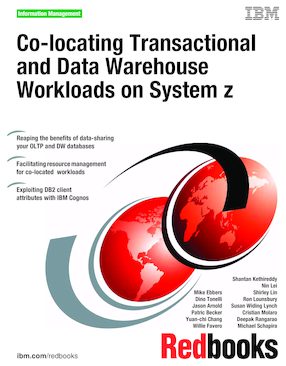Abstract
As business cycles speed up, many customers gain significant competitive advantage from quicker and more accurate business decision-making by using real data. For many customers, choosing the path to co-locate their transactional and analytical workloads on System z® better leverages their existing investment in hardware, software, and skills. We created a project to address a number of best practice questions on how to manage these newer, analytical type workloads, especially when co-located with traditional transactional workloads.
The goal of this IBM® Redbooks® publication is to provide technical guidance and performance trade-offs associated with resource management and potentially DB2® data-sharing in a variety of mixed transactional / data warehouse System z topologies. The term co-location used here and in the rest of the book is specifically defined as the practice of housing both transactional (OLTP) and data warehouse (analytical) workloads within the same System z configuration. We also assumed that key portions of the transactional and data warehouse databases would reside on DB2 for z/OS®. The databases may or may not reside in a DB2 data-sharing environment; we discuss those pros and cons in this book.
The intended audience includes DB2 data warehouse architects and practitioners who are facing choices in resource management and system topologies in the data warehouse arena. This specifically includes Business Intelligence (BI) administrators, DB2 database administrators (DBAs) and z/OS performance administrators / systems programmers. In addition, decision makers and architects can utilize this book to assist in making platform and database topology decisions.
The book is divided into four parts.
Part I, "Introducing the co-location project" covers the System z value proposition and why one should consider System z as the central platform for their data warehousing / business analytics needs. Some topics are risk avoidance via data consolidation, continuous availability, simplified disaster recovery, IBM Smart Analytics Optimizer, reduced network bandwidth requirements, and the unique virtualization and resource management capabilities of System z LPAR, z/VM® and WLM. Part I also provides some of the common System z co-location topologies along with an explanation of the general pros and cons of each. This would be useful input for an architect to understand where a customer is today and where they might consider moving to.
Part II, "Project environment" covers the environment, products, workloads, workload drivers, and data models implemented for this study.
The environment consisted of a logically partitioned z10™ 32way, running z/VM, Linux®, and z/OS operating system instances.
On those instances we ran products such as z/OS DB2 V9, IBM Cognos® Business Intelligence Version 8.4 for Linux on System z, InfoSphere™ Warehouse for System z, InfoSphere Change Data Capture, z/OS WebSphere® V7, Tivoli® Omegamon for DB2 Performance expert.
Utilizing these products we created transactional (OLTP), data warehouse query, and data warehouse refresh workloads.
All the workloads were based on an existing web-based transactional Bookstore workload, that's currently utilized for internal testing within the System p® and z labs.
While some IBM Cognos BI and ISWz product usage and experiences information is covered in this book, we do not go into the depth typically found in IBM Redbooks publications, since there's another book focused specifically on that.
One exception to this is the InfoSphere Change Data Capture product, in which we did include some step-by-step implementation details, as this information was less readily available at the time of this project.
Part III, "Implementation considerations" is the core of the book and covers the resource allocation, management and monitoring co-location implementation considerations for z/OS and DB2 for data warehousing. This includes both single z/OS system implementation as well as DB2 data-sharing between the transactional and data warehouse DB2s. It starts out with an overview to help bridge perspectives of the various administrators. It then covers DB2, WLM, and I/O resource considerations, then provides guidance on bridging the DB2 and WLM views of resource usage. Finally, it provides experimental data covering several resource management facets in two of the key co-location topologies (Single LPAR / separate DB2 sub-systems, Multi-LPAR DB2 data-sharing).
Part IV, "Project experiment results" describes the results of our experiments and provides guidance for others to be able to co-locate their own workloads in a System z environment.
Table of Contents
Part 1. Introducing the co-location project
Chapter 1. Executive summary
Chapter 2. Why System z for data warehousing
Chapter 3. Co-location topologies
Part 2. Project environment
Chapter 4. Co-location data models
Chapter 5. BookStore workload 1 - transactional
Chapter 6. Bookstore workload 2 - IBM Cognos BI reporting
Chapter 7. Bookstore workload 3 - Data Warehouse refreshing
Chapter 8. Our test configuration and infrastructure
Part 3. Implementation considerations
Chapter 9. Performance monitoring and management of queries overview
Chapter 10. Considerations for data warehousing with DB2 on System z
Chapter 11. Resource management of data warehouse mixed workloads
Chapter 12. DB2 data sharing workload balancing and fault tolerant configuration
Chapter 13. Utilizing DB2 Client information for resource management/monitoring
Chapter 14. I/O considerations
Part 4. Project experiment results
Chapter 15. Single z/OS LPAR topology experiments
Chapter 16. Multiple z/OS LPAR experiments
Appendix A. InfoSphere Change Data Capture DDL and binds
Appendix B. Additional performance data
Appendix C. Using DB2 accounting data for setting WLM period durations
Appendix D. Sample WLM service definition
Appendix E. Setting up the transactional workload
Appendix F. WLM refresher
Others who read this also read
